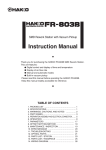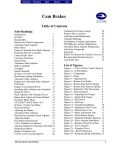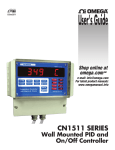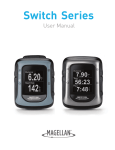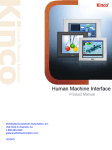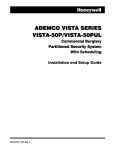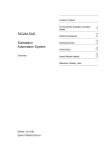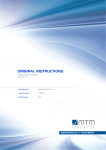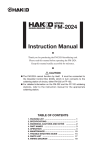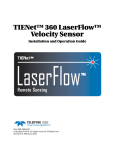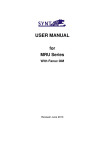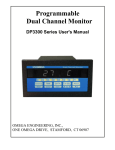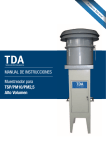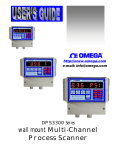Download user`s manual - EWD Solutions
Transcript
Operation and Maintenance Manual Rev 2005-08 TABLE OF CONTENTS Section Item Page 1.0 System Overview 1 2.0 Unpacking & Installation 12 3.0 Rework Process Overview 14 4.0 Operation 16 5.0 Options 19 6.0 Maintenance & Troubleshooting 21 7.0 HMI Software Guide 29 8.0 Advanced Rework Profiling and Control Software 39 1.0 System Overview 5 3 9 2 4 11 12 8 1 10 13 Figure 1: FR-1418 ITEM NO. DESCRIPTION 1 BASE ASSY 2 BRIDGE ASSY 3 HEAD ASSY WITH REAR ENCLOSURE 4 LCD ADAPTER PLATE 5 LCD MONITOR 6 PC CPU (OPTIONAL) 7 PC MNTR, KBD, TRACKBALL (OPTIONAL) 8 NOZZLE SET STANDARD 9 CAMERA/ZOOM LENS ASSY 10 PCB (BOARD) FIXTURE 11 OPTICS TRAIN 12 MIRROR ASSEMBLY 13 FINE ADJUST MECHANISM 1 The previous picture and table are meant to familiarize the user with the terminology used to describe the major components of an FR-1418 BGA Rework System. The figures below describe the specific features and controls found on the FR-1418 BGA Rework Systems. Not all features and controls will be found on all systems, as they vary according to the specific model and options purchased. The items described in the following figures will be referred to throughout the rest of this manual. Front Panel: 3 4 2 6 1 5 Figure 2: Front Panel Controls Item 1 2 3 4 5 6 Description HMI / Operator Keypad w/ LCD Top (Component) Lighting Intensity Control Teach Thermocouple Input (TCH or TC1) Spare Thermocouple Input (TC2) Bottom (Board) Lighting Intensity Control Vacuum Switch and Indicator Lamp* *Note: Some systems may have a footswitch or no switch when controlled by a Host PC. 2 1 3 2 6 11 7 5 4 10 8 12 9 Figure 3: FR-1418 HMI Panel Details Item Description 1 LCD Screen / Message Window 2 L.E.D. Status Indicators 3 Vacuum Toggle Switch and Indicator 4 Start Button, or <Start> 5 Stop Button , or <Stop> or <Esc> or <No> 6 Menu Up Button , or <M↑> 7 Menu Button , or <Menu> or <Yes> 8 Menu Down Button, or <M↓> 9 Set Data Up Button , or <S↑> 10 Set Data Button , or <Set> or <Enter> or <Toggle> 11 Set Data Down Button, or <S↓> 12 Bar Graph Progress Indicator Note: When the unit is controlled by an optional PC with the Thermal Analysis and Control Software installed, the display will read: “UNDER HOST CONTROL” and all keypad actions are ignored. All functions are accessible through the PC software. 3 Figure 4: Lighting Intensity Control Turn clockwise to increase intensity, and counterclockwise to decrease intensity. The TOP lighting (left hand knob) affects the brightness of the video camera image in the UP direction. This is the COMPONENT or NOZZLE image. The BTM lighting (right hand knob) affects the image brightness in the DOWN direction. This is the BOARD image. By varying the intensity in both directions, the operator can view a superimposed image of the COMPONENT or NOZZLE and BOARD for installation or removal of SMT components. Figure 5: Vacuum Control Vacuum can be manually controlled by a front panel pushbutton, footswitch, or PC software. At any time the machine is in a normal RUN mode, actuating the vacuum switch will toggle the vacuum from OFF to ON or from ON to OFF. The vacuum switch is also used during semiautomatic operation to release the COMPONENT from the vacuum tip when placing a component on the BOARD, or when placing a component in the NEST, to indicate to the operator that it is time to continue the cycle after a manual operation. Figure 6: Thermocouple Inputs (TCH Shown) The FR-1418 has (2) Thermocouple (T/C) inputs. The LH input is the TEACH or TCH input, and the RH input is the SPARE or TC2 input. These are Type K T/C inputs. 36 gauge, fine wire, Teflon insulated T/Cs are recommended. The TCH input is used to measure the solder joint temperature. The TC2 input can be used to measure temperature at any point on the board or component being soldered. Note: There must be a T/C or jumper plugged into each port in order for the machine to operate in TEACH or RUN Modes. The system will generate a fault message if either channel is open. 4 Board Fixture and Axis Definition: 4 2 +Z 1 +Y +X 3 Figure 7: Board Fixture The standard board fixture consists of front (1) and rear (2) dovetail rails with adjustable spring clips (3) attached to them. The rear dovetail rail may be adjusted front to back to allow holding boards (also called PCB or PWB) of varying depths. To adjust the rear rail, loosen the black knobs at both ends, and slide the rail forward or backward using one hand on each end. Keep the rear rail parallel to the front rail for easiest adjustment without binding. For convention, left to right on the machine is called the XAxis. The front to back direction is called the Y-Axis. The heater head (4) travels up and down in the Z-Axis. 5 Axis Adjustment Controls: Figure 8: X-Axis Fine Adjust Knob Figure 9: X-Axis Adjust Handle Figure 10: Y-Axis Fine Adjust Knob Figure 11: Y-Axis Adjust Handle Figures 8 through 11 show the X and Y Axis adjustment controls for positioning the heater head relative to the board loaded into the board fixture. To move the head left or right, squeeze the X-Axis adjust handle, and push or pull the head to the desired position. To move the head front to back, squeeze the Y-Axis adjust handle and push or pull the head to the desired position. Fine adjustments, such as when aligning a component or nozzle to a PCB, can be made by rotating the fine adjust knob for the each axis. 6 Figure 12: Theta Adjust The lower heater head can be rotated by turning the Theta Adjust knob. This rotates the nozzle and the vacuum pick-up, so the component and/or nozzle can be aligned to the PCB in the Theta, or rotational, direction. The Theta adjust is a precision assembly with limited travel in either direction. Take care not to continue to turn the knob once the Theta has been adjusted to the end of travel to avoid damaging the assembly. (Also see: Nozzle Installation) Figure 13: Z-Axis Adjust Handle Figure 14: Z-Axis Fine Adjust Knob 7 Figure 15: Z-Axis Rack Gear Assembly Adjusting the heater head height (figures 13 and 14): 4 1 7 5 6 3 2 The Z-Axis adjust handle (1) is attached to the heater head. It is used to select the rough position of the heater head (7). This position is either UP or DOWN. Squeezing the adjust handle disengages a pin from the Z-Axis fine adjust rack gear assembly (3), allowing the head to be lifted or lowered to the top (4) or bottom (5) travel stop. There is a slot in the rack assembly at either end of travel in which the pin engages when the adjust handle is released. The Z-Axis Fine Adjust Knob (2) rotates a pinion gear (6), which moves the rack assembly up or down. This provides additional up and down adjustment of the head when it is in either the UP or DOWN rough position. During general use the rack assembly should always be adjusted UP using the knob, unless the operator is in the process of picking, placing or soldering a component. This ensures that there will be adequate clearance between the heater nozzle and the board or nest when a rapid move is made between the UP and DOWN rough positions. 8 Heater Head and Nozzle Installation: Figure 16: Lower Heater Head Details 5 8 4 1 7 2 2 3 6 The lower heater head assembly is supported by the theta adjustment bearings, which are mounted to the heater plate (7). The lower heater housing (1) rotates using the theta adjust (8). The heat path from the upper heater head to the lower heater head is closed by a spring-loaded bronze seal (4). Vacuum is generated by a venturi in the rear head enclosure. The vacuum tip (6), not visible in Fig. 16, receives vacuum through a Teflon tube connected to the vacuum transfer pipe (5). The vacuum tips are interchangeable for placing and removing different size and weight SMT components. Interchangeable nozzles (3) are held into the lower heater housing (1) by three spring-loaded clips (2). Changing Nozzles: Heater nozzles are available in different sizes, end-shapes, and styles. They are generally low-mass stainless steel shrouds with a machined top flange or hub which engages the lower heater housing. To remove a nozzle (3), grasp the shroud and tilt the lower end of the nozzle slightly away from one of the spring loaded clips (2), while pulling straight down. To insert a nozzle, center the theta adjustment (see note), hold the nozzle by the shroud, insert the vacuum tip through the opening in the top of the nozzle, place the flange of the nozzle over two of the spring clips (2) at a slight angle, and then push the nozzle straight up until the other side of the flange snaps past the third spring clip. CAUTION! Nozzles may be VERY HOT! Hot nozzles can cause severe burns. Use adequate hand protection when changing a hot nozzle, or wait for the nozzle to cool before changing. Note: The range of theta adjustment for the heater head is limited. Attempting to force the theta adjustment beyond its intended travel will damage the assembly. To minimize the possibility of this occurring, observe the following: Before installing each nozzle it is best to center the theta adjustment in its travel range and install the nozzle at the approximate rotation angle required for installation or removal of the SMT component (usually 0, 90, or 45 degrees.) 9 Video Camera and Optical Alignment System: (Figures 17 & 18) A video/optical system aids the operator in aligning the nozzle or component to the board. To use the alignment system, put the head in the UP position, and slide the optics train (10) to its right-most position underneath the nozzle. Top lighting (1) illuminates the component and/or the end of the nozzle and vacuum tip. Bottom lighting (2) illuminates the board. Light reflected from the component and board travels through the beam-splitting prism (3), reflects off the flat mirror (4), into the zoom lens (9), and finally onto the CCD imaging device (8). The CCD imaging device transmits a video signal to an LCD flat screen, an analog monitor, or a PC for high magnification viewing of the superimposed component/board image. The intensity of the component or board image can be adjusted by varying the light intensity. The image is adjusted using the focus (5), zoom (6), and f-stop (7) controls on the zoom lens (9). Always focus the camera on the BOARD and adjust the Z height of the component or nozzle to focus the top image. When focusing a component, adjust the Z height of the component so that the pitch of the leads on the component matches the pitch of the in-focus pads on the board. This is easiest when the X/Y/Theta adjusts are used to set the leads on the component parallel to, and one-half pitch offset in the Y direction from the pads on the board. 7 8 6 1 5 9 3 4 10 2 4 Figure 18: Camera & Zoom Lens Figure 17: Optics Components 10 Component Nest: Figure 19: Component Nest The component nest (1) is provided for aligning a component to the heater nozzle, and for receiving a hot component after it has been removed from the board. The system is furnished with a generic plate (not shown) which fits into the component nest to aid in aligning new components with the heater nozzle (5). Component Print Frames, or CPF (2), also fit into the component nest, and are available for stencil printing solder paste onto BGA (3) and some other SMT components. 2 1 4 3 5 Note: The component nest and optics train are shown in their retracted positions. The component nest (1) and optics train (4) must be fully retracted for the head to be lowered to the DOWN position. With the head UP, extend the component nest to its right-most position to align the center of the nest insert (2) with the nozzle (5) for receiving hot components, or transferring a new component to the nozzle. Rear Panel: 4 1 5 6 3 2 7 Figure 20: Rear Panel Item 1 2 3 4 Description Rear Panel On/Off Switch (Power Switch) Air/N2 Supply Inlet (1/4” Tubing) Services to Head Assembly Item 5 6 7 11 Description Serial Number Decal Host PC and/or Options Connector(s) Power Cord 2.0 Unpacking and Installation: The rework system packaging may vary due to the specific model purchased, options installed, and shipping/transportation requirements. The following figures provide a general guide for unpacking the system. 2 2 1 6 5 8 7 3 4 Figure 21: Outer cardboard or crating removed 9 Figure 22: Bracing and Plastic Removed To unpack the machine: Remove the outer cardboard or wooden crating material. Remove the two 5/16 lag bolts (2), and the hold-down brace (1) from the cushioned skid (4). Remove the outer plastic sheeting, shrink wrap or optional vapor-barrier bag (3). Remove the nozzle kit (5), accessory pack (6), and any LCD monitor (7) and/or optional equipment. The machine can now be lifted off the skid using at least two people. The uncrated machine weighs approximately 140 pounds. Place the machine on a stable bench with a solid top. The bench should not wobble or bend under the weight of the machine. If necessary adjust the four leveling feet so that the machine sits flat on the bench without rocking. Remove any final shrink wrap, plastic or foam, except the foam block (8) under the head. Raise the head to remove the final foam block. Remove the cardboard (9) covering the bottom heater. Y-Axis Figures 22 & 23: Axes Blocked 1 1 1 1 X-Axis 12 Stop Collars (1) are used to secure the axes for shipment. Loosen the #10-32 set screws and slide the collars out of the way. Power and Air/N2 Connections: Connect air or nitrogen to the rear panel fitting using ¼ inch plastic tubing. (See Fig. 20 on page 11) The supply gas must be clean, dry and regulated to 60PSI. The supply should be capable of delivering 5 CFM minimum continuous supply at 80 PSI. Poor filtration or wet air lines will degrade heater and pneumatic component performance. Plug the power cord into an appropriate, dedicated 120VAC outlet. It is now safe to turn on the power to the machine. The machine will run through a brief self-check on power-up and then be ready for operation. See section 4.0 Operation and Programming, Section 7.0 HMI Software guide, or Section 8.0 Thermal Analysis and Control Software for more information. Repackaging the system: Reverse the unpacking procedure, taking special care to secure all moving parts as indicated. Note: The minimum packaging for local delivery or relocating of systems requires that the machine be securely fastened to a cushioned skid, with the head blocked, axes locked, bottom heater covered, and system shrink-wrapped as described in this section. 13 3.0 Process Overview This section is intended to provide a brief and general overview of the SMT rework process using the FR-1418. Your process and corresponding requirements may vary considerably. The typical rework process using this equipment would include the following three phases, each of which has several steps. Rework Phases I. Component Removal II. Board and Component Preparation for Installation III. Component Installation Rework Phase I - Component Removal Typical steps: 1. Load the board with the component to be removed in the board fixture.(Fig. 7) 2. Align the nozzle with the component using the video image and X/Y/Theta adjust knobs (Fig. 8-12, 17, 18) 3. Retract Optics and lower head near board (Fig. 13-15) 4. Press <Start> to initiate the RUN/REMOVE Heat Cycle (Fig. 3, Section 4.0, Section 7.0) 5. When the heat cycle is complete, the vacuum comes on. Adjust Z height to pick up the component (Fig. 14) 6. Raise heater head (Fig. 13-15) 7. Move the component nest/CPF under the hot component (Fig. 19) 8. Lower the head near the component nest and press the VAC switch to drop the component and continue the cycle. 9. After a timed cooling step, the cycle is complete. 10. Retract the component nest and raise the head. (Fig. 19, 14) Note: See the items referenced after each step for additional information in this manual. Rework Phase II - Board and Component Preparation Practices vary widely, but they may consist of the following steps: 1. Remove excess solder and level the pads with solder wick and soldering iron (Fig. 24 & 25) 2. Print fresh solder paste onto BGA balls using CPF stencil (Fig. 26) Note: In many cases for plastic BGA components with eutectic solder balls, a thin coating of flux paste is applied to the board in lieu of adding additional solder paste. 3. Load CPF with BGA into component nest (Fig. 19) 14 Rework Phase III – Component Installation typically consists of the following steps: 1. Load PCB onto adjustable board fixture (Fig. 7) 2. With the head UP, load the component in the nest and slide it under the nozzle (Fig. 13-15, 19) 3. Press <Start> to initiate the RUN/INSTALL cycle. The vacuum turns on. (Fig. 3, Section 4.0, Section 7.0) 4. Adjust the head Z height down to pick up the component and then up away from the nest (Fig. 15) 5. Retract the nest and extend the optics train under the nozzle with the component (Fig. 19) 6. Using the video image and X/Y/Theta adjustments, align the leads (balls) on the component to the pads on the PCB (Fig. 8-12, 17, 18, 27, Section 4.0) 7. Retract the optics train, move the head DOWN to the board. (Fig. 19, 13-15) 8. Adjust the Z height so the component is just touching the board (Fig. 15) 9. Press the VAC button or footswitch to release the component and continue the cycle (Fig. 3) 10. Adjust the Z height so the nozzle is approximately 1/8 inch above the top of the component (Fig. 15) 11. The cycle continues heating through Preheat (PH), Soak (SK) and Reflow (RF) steps. (Section 7.0) 12. The cycle progresses to the Cooling (CL) step, while air flows through the heater nozzle to freeze the solder joints. The cycle is complete. (Section 7.0) 13. When the board has cooled sufficiently, remove it from the board fixture (Fig. 7) 14. Proceed to electrical test, visual inspection, or x-ray inspection of the reworked assembly as required Figure 24: Removing Excess Solder Figure 25: Leveling Pads using Solder Wick & Flux 15 Balls Pads Figure 26: Printing BGA with Solder Paste Figure 27: Aligning the Component 4.0 Operation Note: The operation and programming of the FR-1418 requires that the operator have reasonable proficiency with the features, controls and processes described in Sections 1.0, 3.0, 7.0, and 8.0 (if applicable) of this manual. Read and understand sections 1.0, 3.0, 7.0, and 8.0 (if applicable) before proceeding to operate and program the equipment as described in this section. Note: Consult the references in parentheses after each item for additional information or description relevant to each topic. General Warnings: 1. Keep in mind that the system is designed to melt solder joints on very dense boards. The heaters are very powerful and can reach internal air temperatures exceeding 450° C (840° F). Surfaces of the heater, PCB, nozzle, and other components can be VERY HOT. Always use caution to prevent accidental burns, especially when changing nozzles, unloading boards or components, or when working around the heater head area. 2. Never touch any glass optics components with bare hands. 3. Never wipe any glass optics components with rags or paper towels. Use an optical wipe, camera lens tissue, eyeglass wipe, or other material which will not scratch the glass. 4. Never touch the sides (unpolished faces) of the prism. The oil from your hands can penetrate the bonded seam and adversely affect the image quality. 5. Never touch the halogen bulbs for the component/board lighting, or the bottom heater quartz lamps with bare hands. The oils from your skin can cause hot spots on the bulbs/quartz lamps, resulting in cracking or coating failure. 6. Maintain good ESD prevention procedures when handling electronic components and boards. 7. Always disconnect the unit from the electrical and pneumatic supplies before servicing or maintenance. 16 Powering the System: 1. Check that air/N2 and power are properly connected. 2. Turn the power switch to the 1 (On) position. (Fig. 20) 3. Observe startup messages on LCD screen. Wait for READY. (Fig. 3 and Section 7.0) 4. The system is in INSTALL/RUN or REMOVE/RUN mode, with the last-used recipe loaded in memory. (Section 7.0) Operation for Component Removal (Desoldering): 1. Load the desired Recipe using the MENU buttons (Fig. 3 and Section 7.0) 2. Select REMOVE/RUN or REMOVE/TCH mode using the MENU buttons. If REMOVE/TCH is selected, place the tip of the TCH T/C in contact with the component solder joint. (Fig. 3, 6, and Section 7.0) 3. Insert the proper nozzle into the heater head (Fig. 16) 4. Insert the standard nest plate into the nest (Fig. 19) 5. Align the nozzle to the board using the video alignment optics. (Fig. 17, 18) 6. Lower the head to the rough DOWN position and then adjust the nozzle height to approximately 1/8 inch above the component to be removed. The nozzle should NOT be touching the component. (Fig. 13-15) 7. Press <Start> to initiate the heating cycle. The system will progress through Preheat (PH), Soak (SK) and Reflow (RF) steps at the programmed top and bottom heater settings. When in REMOVE/RUN mode, the system will run at the programmed step heater settings for the step times programmed in the recipe. (This is a time-driven cycle.) When in REMOVE/TCH mode, the system will heat at the programmed step heater settings until the TGT temperature is reached by the TCH T/C. (This is a temperature driven cycle, and is dependent on T/C feedback. Make sure the T/C is securely in contact with the solder joint to ensure accurate temperature readings.) An L.E.D. bar graph progressively illuminates from bottom to top, indicating progress through the cycle (Fig. 3 and Section 7.0) 8. At the completion of the RF heating time, the vacuum will turn on, and the system will begin to beep. Adjust the Z height (Fig. 15) to bring the vacuum tip in contact with the top of the component, and allow the vacuum to engage the component. 9. Adjust the Z height back away from the board at least 1/2 inch, and then raise the head to the rough UP position. (Fig. 15) 10. Slide the component nest under the hot component, and lower the head near it. (Fig. 19) 11. Press the VAC button to release the component from the tip, and initiate the Cooling (CL) timed step, then retract the head away from the nest. 12. The cycle is complete when the CL timer reaches the programmed value. Note: Once the vacuum turns on at the completion of the RF recipe step, the operator has 20 seconds to remove the component from the board and place it in the nest (Steps 8 through 11, above.) If the VAC button is not pushed within 20 seconds, the system will go into an alarm fault mode and terminate the run to prevent accidental board overheating. 17 Note: When in REMOVE/TCH mode, the step times in the recipe are updated automatically upon the completion of the TCH cycle. Operation for Component Installation (Soldering): 1. Load the desired Recipe using the MENU buttons (Fig. 3 and Section 7.0) 2. Select INSTALL/RUN or INSTALL/TCH mode using the MENU buttons. If INSTALL/TCH is selected, place the tip of the TCH T/C in contact with the component solder joint. (Fig. 3, 6, and Section 7.0) 3. Insert the proper nozzle into the heater head (Fig. 16) 4. Insert the component into the nest with the standard nest plate or optional CPF. Solder paste or flux paste may be pre-applied to some components when using a CPF. Orient the component to meet any polarity requirements for the PCB assembly. (Fig. 19, Section 3.0) 5. With the head in the rough UP position, slide the nest under the heater nozzle (Fig. 19, 13-15) 6. Press <Start>. The vacuum turns on. 7. Adjust the head down to pick up the component, and then raise the head away from the nest (Fig. 15) 8. Align the leads on the component to the pads on the board using the video alignment optics. (Fig. 17, 18) 9. Lower the head to the rough DOWN position and then adjust the nozzle height to place the component on the board. The component should touch, but not push on the board. Press the VAC button or footswitch. The heaters will turn on and the cycle will continue with the PH step after a short delay which allows the vacuum to dissipate. Immediately adjust the nozzle Z height to approximately 1/8 inch above the component. The nozzle should NOT be touching the component. (Fig. 13-15) 10. The system will progress through Preheat (PH), Soak (SK) and Reflow (RF) steps at the programmed top and bottom heater settings. When in INSTALL/RUN mode, the system will run at the programmed heater settings for the step times programmed in the recipe. (This is a timedriven cycle.) When in INSTALL/TCH mode, the system will heat at the programmed step heater settings until the TGT temperature is reached by the TCH T/C. (This is a temperature driven cycle, and is dependent on T/C feedback. Make sure the T/C is securely in contact with the solder joint to ensure accurate temperature readings.) An L.E.D. bar graph progressively illuminates from bottom to top, indicating progress through the cycle (Fig. 3 and Section 7.0) 11. Cooling (CL) is the last timed step. When this is complete, adjust the head away from the component, and then raise the head to the rough UP position. 12. The board may be removed when it has sufficiently cooled. Note: When in INSTALL/TCH mode, the step times in the recipe are updated automatically upon the completion of the TCH cycle. (See Section 7.0 for detailed information on the recipe.) 18 5.0 Options A variety of nozzles, vacuum tips, accessories and factory installed options are available to meet the needs of different rework applications. Consult your sales representative for the most up-to-date information on accessories and options. Some major system options are briefly described below. Additional operation and maintenance supplements to this manual may be supplied with some options. Major System Options: 1. Two-Zone Bottom Heater – This option provides a second, 10 x 12 inch bottom infrared heating zone which can be turned on or off in any heating step of each recipe. The total bottom heat area with this option installed is 12 inches in the Y direction and 20 inches in the X direction. The left-hand zone is Zone 1 in the recipe, while the right-hand zone is Zone 2. Figure 28: Two-Zone Bottom Heater Option 2. Thermal Analysis and Control Software – An advanced software control and temperature profiling software package is available that allows the rework system to be controlled by a Pentium™ class PC with its serial port connected to the HOST PC connector (Fig. 20) on the machine’s rear panel. This software also allows the recipes to be created and stored on the PC. Thermocouple data can be plotted real-time, stored, and analyzed using software tools for measuring ramp rates, time above melting temperature, and more. The customer can purchase software only, and provide their own PC, or the software can be preinstalled on a PC with a frame-grabber card for viewing the video camera images using a 15 inch or 17 inch PC monitor. (This option may not currently be available for all models.) 3. Automatic Motorized Z Axis – This option is only available if option 2, above, is installed. It is only available as a factory-installed option. The Heater head is driven by a motorized lead screw, making the Z-Axis of the machine automatic. This allows more automated rework cycle operation, with the pick-and-place operations programmed into the recipes, and controlled by the PC software. (This option may not currently be available for all models.) 19 Figure 29: Automatic Motorized Z-Axis Option 20 6.0 Maintenance and Troubleshooting Important: Always disconnect the unit from the electrical and pneumatic supplies before servicing or performing maintenance. Maintenance: Linear Bearing Rails All linear bearing rails should be cleaned once a month with a tack rag to remove debris, dust and dirt from the rails. A Medium lubricant such as Way Oil should be applied to the X-Y and Z rails/linear bearing rails once every three months. At the factory, we use Mobil Vactra™ #2 (ISO 68) Medium Way Oil. Bottom Heater IMPORTANT: NEVER TOUCH THE HEATER LAMPS WITH BARE HANDS! The bottom heater should be cleaned of dust and debris as needed. If large amounts of dust and debris accumulate inside the bottom heater, remove the top cover and collimator grille, vacuum the interior, and clean the reflectors and bulbs with isopropyl alcohol and a wipe. Prism & Mirror IMPORTANT: NEVER TOUCH THE PRISM OR MIRROR WITH BARE HANDS! Natural oils from your skin may cause permanent damage to the surfaces or bond interfaces. The prism and mirror should be cleaned once (1) a month with a non-abrasive tissue. Lens cleaner (preferred) or isopropyl alcohol can be added to the tissue to remove difficult or heavy deposits. If alcohol is used however, a second pass with a dry non-abrasive tissue is recommended to remove any haze. At the factory we use Bausch & Lomb Sight Savers® #8566. IMPORTANT: NEVER LEAVE THE COMPONENT/BOARD LIGHTING ON FOR AN EXTENDED PERIOD OF TIME OR WHILE THE SYSTEM IS UNATTENDED! Excessive heat from the halogen lighting system can damage the bond interfaces of the prism. Vision Calibration The vision system on the machine should be verified and/or calibrated annually. This is completed using the Calibration Kit included with the machine. A detailed procedure is explained below. Z-Axis Lead Screw Shaft (for systems with Motorized Z-Axis) This should be lubricated once (1) every six months. Manually drive the top heater head down to the bottom home position, then turn the Power OFF. The shaft should be lubricated with a heavy grease which will not melt or run at moderate temperatures, preferably a Lithium Grease compound (12Hydroxy Lithium Complex). At the factory we use StaPlex Premium E.P.. Restore power, and “Home” Z-Axis. Other The machine should be kept clean to prevent build up of flux or other substances or objects that may degrade performance or damage the machine. 21 Troubleshooting: Below is a general guide for troubleshooting certain operational problems. Consult a qualified service technician if you do not understand basic troubleshooting techniques, or if the problem can not be identified and corrected using the information provided in this manual. Troubleshooting table: Symptom Weak vacuum at tip Component is not placed accurately compared to video image Bottom heater does not turn on as programmed Component or board lighting does not work Vacuum tip not centered in video window Possible Cause Worn or damaged vacuum cup Leaking vacuum system Insufficient supply pressure or volume Improper Z height when vacuum is turned off Component sticks to vacuum cup and then drops back to board inaccurately Optical calibration is inaccurate A quartz lamp is burnt out A short circuit caused a blown fuse A halogen bulb is burnt out Optics train stop requires adjustment Flat mirror requires adjustment References Fig. 29 Find and repair leaks in the vacuum system Fig. 29, 30 Increase supply pressure above 60 PSI. Check supply capacity meets CFM requirements and check supply tubing. Review Section 4.0 for proper placement technique. Fig. 20 Section 2.0 Clean vacuum tip, use a different size vacuum tip, or modify Z height used when placing and releasing the component on the board. Verify and/or re-calibrate according to the procedure below. Inspect the lamp filaments. Replace burnt-out lamps Find and correct the cause of the short circuit, then replace the fuse. Inspect the bulb filaments. Replace burnt-out bulbs Check and/or adjust the optics train stop as described in the optical calibration procedure Check and/or adjust the flat mirror as described in the optical calibration procedure Section 4.0 Section 4.0 Fig. 29 Fig. 33, 34 Fig. 31, 32 Fig. 35 Fig. 36 Figure 29: Vacuum Pick-Up System 5 4 3 6 Corrective Action Replace the vacuum cup 1 2 Interchangeable vacuum tips (1), which may or may not have a silicone vacuum cup (2), are screwed into the vacuum stem (3) with #10-32 threads. The vacuum transfer tube (4) pipes the vacuum from the tubing (5) to through the lower heater housing (6) to the stem. A vacuum generator (Item 2, Fig. 30), generates the vacuum pressure. A leak anywhere in this system may cause weak vacuum at the tip. 22 1 2 9 7 8 3 4 5 10 11 6 Figure 30: Rear Head Enclosure Details Item 1 2 3 4 5 6 Description Rear head enclosure Vacuum generator Medium air flow solenoid valve Low air flow solenoid valve Vacuum generator feed solenoid valve Air pressure switch Item 7 8 9 10 11 Description Low air flow control needle valve Head distribution/dimmer board Heater power connections Heater T/C connection Ground connections Routine Service Procedures: 1. To change the component or board lighting halogen bulbs found on the standard optics train, follow the steps outlined in Figures 31 and 32, below. 2. To change the bottom heater quartz lamps, remove the base cover plate (Fig. 7, Item 5) and collimator grille (Fig. 7, Item 6), and then follow the steps outlined in Figures 33 and 34, below. 3. To replace fuses, first find and correct the cause of the blown fuse, then remove the base cover plate (Fig. 7, Item 5), locate the appropriate fuse on the power board (Fig. 35, Item 3), and replace the fuse with one of the same type and rating. Reinstall the cover. 23 Figure 31: Removing the lighting cover Remove the four corner screws (1) securing the top or bottom lighting cover (2) as required. Carefully pull the cover straight out of the housing (3) with the bulb mount (4) still attached. See Fig. 32, replacement bulbs must be of the exact type as the original equipment (75 W Max.) 1 2 1 3 Figure 32: Changing halogen bulbs 5 4 6 Pull the bulb (5) straight out of the socket (6) and insert the new bulb in the reverse fashion. It may be necessary to slightly bend the contact pins on the new bulb to fit the socket. Do not touch the bulbs with bare hands. Be sure to observe the handling warning stated at the beginning of this section. Take care not to pinch the supply wires (7) when replacing the cover. 7 1 2 Figure 33: Replacing the bottom heater quartz lamps Grasp the lamp (1) near one end. Push slightly towards the opposite contact block (2), then tilt the lamp up and out of the heater assembly as shown. Do not touch the bulbs with bare hands. Be sure to observe the handling warning stated at the beginning of this section. Insert the new lamp in the reverse manner. Figure 34: Checking the bottom heater lamp contacts Grasp the lamp (1) near the center. Push the lamp slightly toward one contact block (2), then the other. You should feel some movement in each direction as the contact springs flex. The lamp should not rattle or feel loose. The lamp should be supported only by the pins in the contact blocks. Rotate the lamp a small amount, in both directions, about its long axis to feel that the bulb is securely seated on the contact pins. 24 7 4 5 3 1 6 2 8 Figure 35: Power Distribution Board 9 12 10 13 11 14 Figure 36: I/O Board Table for Figures 35 and 36: Item 1 2 3 4 5 6 7 Description Power distribution board I/O board Fuses (Individually identified on board) Top and bottom heater power terminals Optional Zone-2 heater power terminals Power control module electrical connections 12 VDC output connector Item 8 9 10 11 12 13 14 25 Description Main power connections to/from power switch Thermocouple input terminals CPU board (plugs into I/O board) 12 and 24 VAC from power board Output connector Input connector Ribbon cable to front LCD HMI Panel Optical Calibration and Adjustments: 3 1 2 Figure 37: Calibration Plate Figure 38: Calibration Tip Calibration Procedure: 1. Remove the covers from the camera lens and light housing (Fig. 17) and install the calibration plate (1) onto the board support. 2. Remove the nozzle and vacuum tip (Fig. 29) and install the calibration tip (2). Adjust the optics train stop according to Figure 39 if necessary. 3. Adjust the mirror according to Figure 40 if necessary. 4. Move the head to the rough DOWN position and then adjust the Z height so the calibration tip (2) is just above the blind hole (3) in the calibration plate (1). 5. Align the calibration tip with the plate as shown in Figure 41. 6. Use the video alignment system to view the superimposed image of the tip and the hole in the plate. It is important not to allow the X and Y axes to move at this time. 7. If the tip and hole in the plate appear concentric, then no adjustment of the prism is required. If the tip and hole appear misaligned, adjust the prism according to Figures 42 and 43. 8. Replace the vacuum tip, and any covers which have been removed. Figure 39: Optics train stop adjustment 4 Bring the head to its uppermost position. Move the optics train to the right until it stops (Fig. 17). Adjust the Z height so the calibration or vacuum tip is just above the top lighting and visually check that the tip is centered left to right with respect to the prism. Gauge the centering of the prism with a graduated scale, if one is available. If the optics train position requires adjusting, adjust the stop screw (4) accordingly. 26 Figure 40: Mirror adjustment 7 Return the head to its uppermost position and turn on the LCD monitor. Move the optics train (7) to its right-most position. Loosen the locking screw (5) on the mirror bracket very slightly and, using the three set screws (6), adjust the mirror so the nozzle tip appears in the center of the video image. Adjust the lens zoom control through its entire travel to ensure the image remains centered on the screen. Re-tighten the center screw. 5 6 Figure 41: Aligning the calibration tip with the plate Adjust the head down and align the calibration tip (2) with the blind hole in the calibration plate (3) using the X and Y fine adjustments. Adjust the X and Y axes so that the tip can be moved easily in and out of the hole in the Z direction. 2 3 9 8 12 9 11 Figure 42: Prism Left/Right Image Adjustment 27 12 11 10 10 8 Figure 43: Prism Front/Rear Image Adjustment To Adjust The Prism: The prism (11) is bonded to an adjustable mount (12), which allows it to be oriented squarely to the ZAxis. This can correct any optical image misalignment observed during the calibration procedure, above. Do not adjust the prism mount for any reason, unless the above calibration procedure indicates you should do so. Slightly loosen the three socket head cap screws (8) on the prism bracket. To correct a left-to-right image misalignment, adjust the set screws (9) to produce the desired effect. To correct a front-to-back (top-to-bottom on video monitor) image misalignment, adjust the set screws (10) to produce the desired effect. (Note: When adjusting the set screws, loosen one and tighten the opposite one.) After accomplishing the alignment of the two images, gently tighten the three socket head cap screws on the prism bracket. Watch the video image as the screws are tightened to ensure that the images stay aligned. 28 7.0 HMI Software Guide FR-1418 FRONT PANEL OPERATION POWER-ON & RUNNING A RECIPE --PLEASE WAIT-- First application of power: AMERICAN HAKKO REWORK SYSTEM Unit says: ”American Hakko Rework System” REV X Note: The current software revision (X ) is displayed on the right side of the screen. Unit shows recipe ## is loaded and ready to run by pushing <START> (or push <MENU> to get main menu). RUN INSTALL... PRESS <START> ## RUN READY RUN MODE PRESS <START> ## RUN READY Note: ## indicates recipe # which is ready to run. MAIN MENU From the “RUN READY” screen... push the <MENU> keys to get additional menu choices: Note: Mode indicates either install or remove. Use the MENU UP, MENU DN keys to navigate from MENU to MENU. Push <MENU> to select the choice shown. CHANGE TO MODE? <^><v> OR <MENU>=YES Select “CHANGE TO INSTALL OR REMOVE” screen to toggle between install and remove modes. --OR-<STOP> TO EXIT Note: Mode indicates either install or remove. LOAD NEW RECIPE ##? <^><v> OR <MENU>=YES Select “LOAD NEW RECIPE” to go to a screen where a new Recipe # can be chosen. --OR-<STOP> TO EXIT 29 EDIT/TEACH SETTINGS? <^><v> OR <MENU>=YES Select “EDIT/TEACH SETTINGS” to Edit or Teach a Recipe. --OR-<STOP> TO EXIT SETUP/DIAGNOSTICS? <^><v> OR <MENU>=YES Select “SETUP/DIAGNOSTICS” to enter Setup Mode (pgm password) or run Diagnostics. --OR-<STOP> TO EXIT MANUAL MODE? <^><v> OR <MENU>=YES Select “MANUAL MODE” to run the bottom heaters manually. --OR-<STOP> TO EXIT RAMP & HOLD MODE? <^><v> OR <MENU>=YES Select “RAMP & HOLD MODE” to control the bottom heaters based on a desired set point temperature and an actual thermocouple reading. --OR-<STOP> TO EXIT LOADING A NEW RECIPE TO RUN From MAIN MENU, select “LOAD NEW RECIPE”. Use the SET UP, SET DN keys to increment/decrement the recipe #. Push the <SET> key to accept the choice. #00=RECIPE NAME <^><v> OR <SET>=ENTR Note: The unit holds 100 (#00-#99) recipes in non-volatile memory. ENTERING THE PASSWORD Use the SET UP, SET DN keys to enter the 1st digit of the password and push <SET> Repeat until all 6 password digits are entered PASSWORD? (6 DIGITS) Note: The system default password is 123. You must push <SET> 3 times to serve as the last 3 digits. 30 *PASSWORD INCORRECT* <MENU> TO TRY AGAIN If the Password was incorrect, push the <MENU> key to try again. --OR-<STOP> TO EXIT *PASSWORD ACCEPTED* <v> FOR CHOICES If the Password was correct, push the MENU DN key to begin. --OR-<STOP> TO EXIT EDITING A RECIPE From MAIN MENU, select “EDIT/TEACH SETTINGS” and enter the password PASSWORD? (6 DIGITS) When the password is entered & accepted (see ENTERING THE PASSWORD) the unit asks if you want to Edit Settings Push the <MENU> key to say yes. EDIT SETTINGS? <^><v> OR <MENU>=YES --OR-<STOP>=EXIT W/O SAVE When Editing a recipe, use the MENU UP and MENU DN keys to skip fields you don’t want to change. When changing a field, use SET UP and SET DN to change the value, then push the <SET> key to enter the value. EDIT NAME (16 DIGITS) Edit the recipe name using SET UP, SET DN keys to change the 1st digit, then push <SET> Repeat process to enter all 16 digits. All 16 digits must be entered with the <SET> key 31 EDIT HEAT 1 SETTINGS Note: Manual displays default values. Note: PH = Preheat Edit HEAT 1 Top Temp using SET UP, and SET DN. Push <SET> to enter the value. PH TOP TEMP =250C <^><v> OR <SET>=ENTR Edit HEAT 1 Air Flow using SET UP, and SET DN. Push <SET> to enter the value. PH AIR FLOW =MED <^> OR <SET>=ENTER Edit HEAT 1 Teach Target using SET UP, and SET DN. Push <SET> to enter the value. PH TEACH TRGT=120C <^><v> OR <SET>=ENTR Edit HEAT 1 Time using SET UP, and SET DN. Push <SET> to enter the value. PH TIME MM:SS 01:30 <^><v> OR <SET>=ENTR Edit HEAT 1 Zones using SET UP, and SET DN. Push <SET> to enter the value. Repeat for both zones. PH ZONES = 1 2 <^><v> OR <SET>=ENTR PH HEAT PERCENT 80% <^><v> OR <SET>=ENTR Edit HEAT 1 Bottom Heat % using SET UP, and SET DN. Push <SET> to enter the value. EDIT HEAT 2 SETTINGS Note: Manual displays default values. Note: SK = Soak Edit HEAT 1 Top Temp using SET UP, and SET DN. Push <SET> to enter the value. SK TOP TEMP =300C <^><v> OR <SET>=ENTR Edit HEAT 1 Air Flow using SET UP, and SET DN. Push <SET> to enter the value. SK AIR FLOW =MED <^> OR <SET>=ENTER Edit HEAT 1 Teach Target using SET UP, and SET DN. Push <SET> to enter the value. SK TEACH TRGT=175C <^><v> OR <SET>=ENTR 32 Edit HEAT 1 Time using SET UP, and SET DN. Push <SET> to enter the value. SK TIME MM:SS 01:00 <^><v> OR <SET>=ENTR Edit HEAT 1 Zones using SET UP, and SET DN. Push <SET> to enter the value. Repeat for both zones. SK ZONES = 1 2 <^><v> OR <SET>=ENTR Edit HEAT 1 Bottom Heat % using SET UP, and SET DN. Push <SET> to enter the value. SK HEAT PERCENT 70% <^><v> OR <SET>=ENTR EDIT HEAT 3 SETTINGS Note: Manual displays default values. Note: RF = Reflow Edit HEAT 1 Top Temp using SET UP, and SET DN. Push <SET> to enter the value. RF TOP TEMP =375C <^><v> OR <SET>=ENTR Edit HEAT 1 Air Flow using SET UP, and SET DN. Push <SET> to enter the value. RF AIR FLOW =MED <^> OR <SET>=ENTER Edit HEAT 1 Teach Target using SET UP, and SET DN. Push <SET> to enter the value. RF TEACH TRGT=215C <^><v> OR <SET>=ENTR Edit HEAT 1 Time using SET UP, and SET DN. Push <SET> to enter the value. RF TIME MM:SS 01:00 <^><v> OR <SET>=ENTR Edit HEAT 1 zone using SET UP, and SET DN. Push <SET> to enter the value. Repeat for all zones. RF ZONES = 1 2 <^><v> OR <SET>=ENTR Edit HEAT 1 Bottom Heat % using SET UP, and SET DN. Push <SET> to enter the value. RF HEAT PERCENT 60% <^><v> OR <SET>=ENTR EDIT COOL 1 SETTINGS Edit COOL 1 Air Flow using SET UP, and SET DN. Push <SET> to enter the value. CL AIR FLOW =LOW <^> OR <SET>=ENTER Edit COOL 1 Time using SET UP, and SET DN. Push <SET> to enter the value. CL TIME MM:SS 00:30 <^><v> OR <SET>=ENTR 33 When you are done editing, push the <STOP> key. If you have made any changes, the unit asks if you want to: Exit & Save = <MENU> key or... Exit without Saving = <STOP> key EXIT & SAVE CHANGES? <^><v> OR <MENU>=YES --OR-<STOP>=EXIT W/O SAVE RUNNING THE RECIPE Push <START> to run the recipe. Note: The following screens are displayed as the unit progresses through a cycle. HEAT 1 T3=XXX T1=XXX 00:00 00:00 01 RUN HEAT 1 HEAT 1 (alternate screen) T3=XXX T1=XXX T2=XXX TCHXXX 01 RUN 00:00 HEAT 2 T3=XXX T1=XXX 00:00 00:00 01 RUN HEAT 2 HEAT 2 (alternate screen) T3=XXX T1=XXX T2=XXX TCHXXX 01 RUN 00:00 HEAT 3 T3=XXX T1=XXX 00:00 00:00 01 RUN HEAT 3 HEAT 3 (alternate screen) T3=XXX T1=XXX T2=XXX TCHXXX 01 RUN 00:00 COOL 1 T3=XXX T1=XXX 00:00 00:00 01 RUN COOL 1 T3=XXX T1=XXX T2=XXX 01 RUN 00:00 COOL 1 (alternate screen) Push any key to exit this screen. or wait 5 seconds CYCLE DONE... ELPSD = 00:00 34 01 TEACHING A RECIPE From MAIN MENU, select EDIT/TEACH SETTINGS and enter the password. PASSWORD? (6 DIGITS) When the password is entered & accepted (see ENTERING THE PASSWORD) the Unit asks if you want to Edit Settings. Push the MENU DN key to get the teach. screen. EDIT SETTINGS? <^><v> OR <MENU>=YES --OR-<STOP>=EXIT W/O SAVE Push <MENU> at the teach screen to run the Teach Mode. The unit will run normally except TCH will show on the LCD instead of RUN, and the times will be taught based on TCH actual temp reaching Teach Temp. (see Running A Recipe) RUN TEACH MODE? <^><v> OR <MENU>=YES --OR-<STOP>=EXIT W/O SAVE When you are done using Teach Mode, push the <STOP> key. If you have made any changes, the unit asks if you want to: Exit & Save = <MENU> key or... Exit without Saving = <STOP> key EXIT & SAVE CHANGES? <^><v> OR <MENU>=YES --OR-<STOP>=EXIT W/O SAVE SETUP/DIAGNOSTICS From MAIN MENU, select SETUP/DIAGNOSTICS and enter the password. PASSWORD? (6 DIGITS) When the password is entered & accepted (see ENTERING THE PASSWORD), the Unit asks if you want System Setup. Pushing <MENU> from this screen allows you to program a new password. Push MENU DN and it asks if you want diagnostics. SYSTEM SETUP? <^><v> OR <MENU>=YES --OR-<STOP> TO EXIT DIAGNOSTICS? <^><v> OR <MENU>=YES Pushing <MENU> from this screen puts you into the Diagnostic Mode. --OR-<STOP> TO EXIT 35 SYSTEM SETUP: (PROGRAMMING A NEW PASSWORD) Use the SET UP, SET DN keys to select the 1st digit of the new password and push <SET> to enter it. Repeat until all 6 password digits are entered. PGM 6 DIGIT PASSWORD: After all 6 digits are entered, this screen is shown. Push <MENU>key to Exit & Save the new password, or push <STOP> to Exit without saving. EXIT & SAVE CHANGES? <^><v> OR <MENU>=YES --OR-<STOP>=EXIT W/O SAVE DIAGNOSTICS The state of the four input lines can be viewed on the LCD readout by pushing <MENU> at this screen. Or push MENU DN to select next diagnostic menu choice. TEST INPUTS? <^><v> OR <MENU>=YES The four output lines can be tested using the LCD readout by pushing <MENU> at this screen. Or push MENU DN to select next diagnostic menu choice. TEST OUTPUTS? <^><v> OR <MENU>=YES The four thermocouple inputs can be tested using the LCD readout by pushing <MENU> at this screen. This is the last diagnostic choice. If you push MENU DN again, it starts over with inputs. TEST THERMOCOUPLES? <^><v> OR <MENU>=YES --OR-<STOP> TO EXIT --OR-<STOP> TO EXIT --OR-<STOP> TO EXIT TESTING THE INPUTS The LCD shows the state of the inputs. Push <STOP> to stop the input testing. IN0=0 IN3=0 IN1=0 N2=0 <STOP>=EXIT OUT0=0 OUT3=0 OUT1=0 OUT2=0 <STOP>=EXIT TESTING THE OUTPUTS Use the SET UP, & SET DN to move the cursor to the four outputs shown on the LCD. Push <MENU> to toggle the output state. Push <STOP> to stop the input testing. 36 TESTING THE THERMOCOUPLES XXXC XXXC The LCD shows the thermocouple temps. Push <STOP> to stop the thermocouple testing. XXXC XXXC <STOP>=EXIT MANUAL MODE Note: Manual Mode is a bottom heat only mode. Manual mode runs the bottom heaters manually. Push <MENU> to manually change bottom heat parameters. Push <STOP> to stop Manual Mode. TCH=XXX TC2=XXX ZNS=1 2 50% MANUAL 00:00 ZONES = 1 2 <^><v> OR <SET>=ENTR Edit bottom heat zones using SET UP, and SET DN. Push <SET> to enter the value Repeat for all zones HEAT PERCENT = 50% <^><v> OR <SET>=ENTR Edit bottom heat percent using SET UP, and SET DN. Push <SET> to enter the value RAMP & HOLD MODE Note: Ramp & Hold Mode is a bottom heat only mode. Ramp & Hold Mode runs the bottom heaters according to a temperature set point. and TCH actual. Push <MENU> to adjust the set point as well as the bottom heat parameters. Push <STOP> to stop Ramp & Hold Mode. Alternate display in Ramp & Hold Mode. Edit bottom heat Zones using SET UP, and SET DN. Push <SET> to enter the value. Repeat for all zones TCH=XXX TC2=XXX SETPOINT=250C R_HOLD 00:00 T1=XXX T2=XXX ZNS=1 2 50% R_HOLD 00:00 ZONES = 1 2 <^><v> OR <SET>=ENTR Edit bottom heat percent using SET UP, and SET DN. Push <SET> to enter the value (this is the highest percent used) HEAT PERCENT = 50% <^><v> OR <SET>=ENTR Edit bottom heat set point using SET UP, and SET DN. Push <SET> to enter the value BOTTOM TEMP =XXXC <^><v> OR <SET>=ENTR 37 FAULT MODE If you run the machine with no air pressure, you will receive this error message. Push <MENU> to clear the message and try again. FAULT... NO AIR <MENU> TO CLR FAULT 38 8.0 Appendix B –Thermal Analysis and Control Software FR-1418 Software Operation Note: This Appendix is a supplement to the FR-1418 Operation and Maintenance Manual. Read about and understand the general machine operation before proceeding. This operator manual supplement is a guide for operating the FR-1418 Rework Systems using the Thermal Analysis and Control Software Package. This software is available as an option on the FR1418 Rework Systems. Some features and functions may not be enabled or available depending on the rework system hardware configuration purchased. Important functions of the software are: • Virtually unlimited recipe storage and retrieval using the PC hard disk drive, or a remote network • Multi-point thermocouple data acquisition, profiling, and analysis to accurately measure temperature vs. time curves used in the soldering process. This includes convenient tools to measure ramp rates, time-above-temperature, and other key indicators relevant to the soldering process. • An easy to use graphical HMI1, for running the rework system using the PC. • Programmable, automatic Z-Axis control2 for systems equipped with Motorized Z-Axis. • Teach-mode interactive programming for simplified development of accurate and repeatable soldering profiles. • Single screen viewing and editing of all computer-controlled recipe parameters. • Advanced, manual controls and optimization tools for experienced users • Process recipe and thermal profile documentation and printing. Notes: 1 Human-Machine Interface 2 Not available on all configurations Main Screen (Figure 1A/Figure 1B): 39 This is the first screen shown upon starting the software. The bottom area of the screen shows the temperature profile graphing area, while the upper part of the screen shows the operation buttons, status, data, timers, recipe name and description. Figure 1A: FR-1418 Thermal Analysis and Control Software – Main (Run) Screen with standard Manual Z-Axis 40 Main Screen (Continued): Figure 1B: FR-1418 Thermal Analysis and Control Software – Main (Run) Screen with optional Automatic Z-Axis The following menus are available in the Main Screen: File -> Open File -> Save File -> Save As File -> Exit View -> Options Help -> Contents Displays a dialog box for opening recipe files Saves any changes made to the current recipe Saves the current recipe to a new file name Exits the program Displays the Options Screen (discussed below) Displays the software’s help file Along the left-hand side are the following buttons: Home Z-Axis Button Start Button Stop Button Install/Remove Buttons Moves the Z-axis to its home position and resets its zero location Starts the currently loaded recipe Stops a running recipe Toggles between these two modes of operation 41 Run/Teach Buttons Toggles between these two modes of operation. In “Run” mode the software will use recorded times for stage control. In “Teach” mode the software will monitor the machine’s thermocouples for stage control and will record the times between stages to be used in “Run” mode Camera View Button Opens the Camera View window (discussed below) Jog Button Opens the Jog window for moving the Z-Axis (discussed below) Manual Control Button Displays buttons and parameters for manually controlling several of the machine’s outputs (discussed below) File Name The file name of the currently loaded recipe file Description A text field of the recipe that can be used to display additional information about the currently loaded recipe Edit Recipe Button This will open the Recipe Setup Screen (discussed below) which is used to edit the currently loaded recipe or create new recipes Part Temp., Board Temp., Top Heater Temp., Spare Temp. These fields show the current and target temperatures of each of the machine’s thermocouples. They can be checked or unchecked to toggle their display on the graph Timers These fields show timer values for each of the process stages, the total time, and the time above reflow temperature 42 Recipe Setup Screen (Figure 2A/Figure 2B): This screen is accessed by clicking on the “Edit Recipe” button on the Main Screen. This screen allows the operator to set the thermal process requirements and the Z-Axis locations for the recipe. The thermal cycle starts with the Board Heater settings and runs through the heating and cooling steps to the end of the process. The small chart in the top-right corner shows a graphical approximation of the Target Profile as determined by the various settings. Figure 2A: Recipe Setup Screen with standard Manual Z-Axis 43 Recipe Setup Screen (Continued): Figure 2B: Recipe Setup Screen with optional Automatic Z-Axis The following is a description of the various items on this screen. File Name & Description Reflow Part Detect This is the same information that appears on the Main Screen. The Description can be edited from here. The amount of time the Part Thermocouple spends above this temperature is displayed in the “Above Reflow” field on the Main Screen. (Auto-Z equipped machines only) This toggles whether or not the vacuum switch is used to detect when a component is on the tip when picking a component from the nest (Install Mode) or the board (Remove Mode). If “Use Vacuum Switch” is selected then the Z-Axis will stop seeking as soon as the vacuum switch is triggered when picking up a component. If “Nest/Board Place” is selected the software will ignore the vacuum switch and use the Nest Place or the Board Place positions from the Z Move Table to determine how far to seek the Z-Axis when picking up a component. In either case, the Nest Place and Board Place positions are always used when placing components. 44 Board Heater Section: Heat Zones 1 & 2 Board Heater Power Start Preheat At Time These buttons toggle which board heaters are active during the process. Sets the power from 0 (off) to 100 (full power) during the Board Preheat Stage. When running in Teach Mode, once the Board Thermocouple reaches this temperature the software will advance to the Heat 1 (Preheat) stage. The time required to reach this temperature will be recorded in the “Time” field. When running in Run Mode this field will be ignored. When running in Run Mode, the software will use this time to determine when to advance to the next stage. Heat Stage Settings: The following settings apply to each of the three heat stages (Preheat, Soak, and Reflow). Part TC Target Heater Temp Time Board Heater Power Air Flow Rate Cooling Stage Settings: Time Air Flow Rate When running in Teach Mode, the software will compare the Part Thermocouple reading to this temperature to determine when to advance to the next stage. The time required to reach this temperature is recorded in the “Time” field. In Run Mode, this field will be ignored. This is the temperature setting for the top heater. In Run Mode, this field is used by the software to determine when to advance to the next stage. The power setting for the board heaters can be set for each stage. The setting can range from 0 (off) to 100 (full power). These three buttons control the air flow setting through the top heater for each stage. The amount of time spent in the cooling stage. Sets the air flow setting for the cooling stage. Z Move Table (Auto-Z equipped machines only) Each recipe has an independent set of Z-positions. The “Set” button next to each field applies the current Z location to that field. The “GoTo” button moves the Z-axis to the current setting for that field. The Jog buttons (opened from the Manual Control button on the Main Screen) can be accessed while the Recipe Setup screen remains open to help set up the Z Move Table. Focus Nest The height at which the underside of the component is in focus when performing an alignment. The height the Z-axis will move to prior to extending the nest in preparation for picking up or dropping off a component. The height should be set to accommodate the thickness of the component to avoid collision with the nest. 45 Nest Place Preheat, Soak, Reflow Board Board Place When placing a component into the nest (or picking up when “Nest/Board Place” is selected in the “Part Detect” section) the Z-Axis will slowly seek to this height with the vacuum turned on. This height is typically set at the point where the vacuum tip just touches the top of the component to avoid placing too much load on the component. Each of these heights controls the position of the Z-axis during each of the three heating stages. The Z-axis will move to this height prior to picking up or placing a component on the board. When placing a component onto the board (or picking up when “Nest/Place Board” is selected in the “Part Detect” section) the Z-Axis will seek to this height with the vacuum turned on. The height should be set at the point where the vacuum tip just touches the top of the component to avoid placing too much load on the component. Camera View Screen (Figure 3): This window is accessed by clicking on the “Camera View” button in the Main Screen. It is also automatically opened by the software during the alignment stage. The camera image is seen in the panel on the right only if the system is equipped with a PC based frame grabber as an option to the standard LCD monitor. Figure 3: Camera View Screen The Camera View Screen has the following elements: Current Z Position Jog Z-Axis Simply displays the current position of the Z-Axis The “Up” and “Down” buttons can be used to jog the Z-Axis while viewing the camera image 46 Save Image Continue & Cancel Clicking this button will capture the camera view to a JPG file. The file is named “capture.jpg” and is stored in the application directory. (Frame grabber equipped systems only.) Both of these buttons will close the Camera View window. When running a recipe clicking the “Continue” button will inform the software that you are finished with alignment and that it can proceed with the rest of the cycle. The “Cancel” button is used for telling the software to end the cycle prematurely. Z-Axis Jog Panel (Figure 4): Clicking the “Manual Control” button on the Main Screen will show this panel. On systems equipped with an automatic, motorized Z-axis, this panel allows manual motion of the heater head Z height for setting the values in the Z Move Table, or for maintenance or manual operating reasons. Figure 4: Z-Axis Manual Controls The Z-Axis Jog Panel has the following elements: Position Move To Speed Up, Down Display the current position of the Z-Axis Clicking this button will move the Z-Axis to the position entered into the adjacent text box. This controls the speed of the Z-Axis when jogging. Jogs the Z-Axis up or down at the speed set by the Jog Speed control. 47 Manual Control (Fig.5): This panel is used for toggling several of the machine’s outputs such as Vacuum and heaters. The machine can be manually operated by using these controls. (Some fields shown may depend upon optional equipment.) Figure 5: Manual Control Panel Options Panel (Figure 6): The Options Panel is accessed by clicking on the “View” menu in the Main Screen and selecting “Options”. From here several configurable options are shown. It is recommended that you consult PMT or your local representative before changing any of these settings as improper values could allow the machine to damage itself. The settings are as follows: Controller 1 (WRD) COM Controller 2 (TriPLC) COM This is the Windows COM port that is connected to the port labeled “Host PC” or “Controller 1” on the rear of the unit This is the Windows COM port that is connected to the port labeled “Option” or “Controller 2” on the rear of the unit. 48 Z Axis CPI Full Speed IPS Slow Speed IPS Seek Speed IPS Default Jog Speed Nest Clearance Set Optics Clearance This stands for “Counts Per Inch” and represents the number of stepper counts per inch of travel on the Z-Axis. This is determined by hardware and must not be changed. This is the speed (in Inches Per Second) the Z-Axis moves during fullspeed motions. This is the speed the Z-Axis moves during slow-speed motions. The speed the Z-Axis moves during seek motions (picking and placing). The speed the Z-Axis moves by default during Jog operations. The actually jog speed can be adjusted using the “Jog Speed” slider in the Jog Panel. This is the height at which the Z-Axis clears the top of the nest plate. If the Z-Axis is below this height then the software will prevent the nest from extending and colliding with it. Likewise, if the nest is already extended and the Z-Axis is commanded to move to a height below this setting then the software will automatically retract the nest to avoid collision. However, when jogging, the software does not check this value. Sets the value to the current Z-Axis position This setting’s purpose and functionality is identical to the “Nest Clearance” but for the Optics assembly. 49 Working with Recipes Creating a new Recipe: 1.) Click on the “Edit Recipe” button from the Main Screen 2.) Select File>>New and then select a recipe template. (A default recipe template default.rct comes with the software. You may create your own templates from any recipe using the Save As file options.) 3.) Edit the recipe parameters as desired. 4.) Save the recipe. Teaching and Running a Recipe: 1.) Open a recipe and check that the parameters represent the rework profile you want to achieve. 2.) Plug a thermocouple into the left-hand port on the front of the machine and attach the exposed junction to a solder joint on the component to be “taught.” It plots on the graph as the Part Thermocouple. 3.) Plug a thermocouple into the right-hand port on the front of the machine and attach the exposed junction to an area of the circuit board away from the target component. This is the thermocouple which will be used to control the “Start Preheat at” temperature as specified in the Board Heater section of the recipe. It plots on the graph as the Board Thermocouple. 4.) Insert the proper nozzle into the machine and align with the target component. 5.) Select Teach and either Install or Remove from the main control screen (Fig. 1). It is recommended to teach recipes in Install mode, since you can see the effect of the cooling and the teach thermocouple remain in place at the end of the run, making it easier to make adjustments to the recipe heating profile. 6.) Run the recipe using the Start button. The system will keep track of the time required to reach the target temperatures programmed into the recipe. The picture below illustrates the machine operating in “Teach Mode.” 7.) If satisfied with the results, save the recipe after teaching. If you want to make adjustments to slow down or speed up heating, etc., Edit the recipe parameters, cool the board down, and reteach the recipe. 8.) When a recipe has been successfully taught and saved, it can be run in Run Mode without thermocouples. Run Mode will use the Preheat Soak and Reflow times learned in Teach Mode. 50 Figure 7 – Screen capture from system operating in Teach Mode. The graph shows that the part thermocouple has passed the Preheat Target (PH: 140) and is approaching the Soak Target (SK: 175). Note that the “Soak” indicator is highlighted bright yellow. This is the active step. The paler colored steps have already been completed. The Current Stage Time counts up in Teach Mode and down in Run Mode. 51 28920 Avenue Williams Valencia CA 91355-4182 United States of America Tel: 661.294.0090 Fax: 661.294.0096 Toll Free: 1.800.88.HAKKO (42556) www.HakkoUSA.com























































